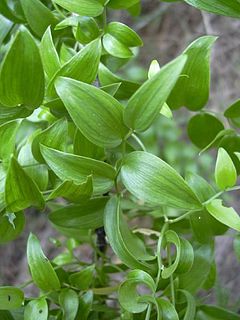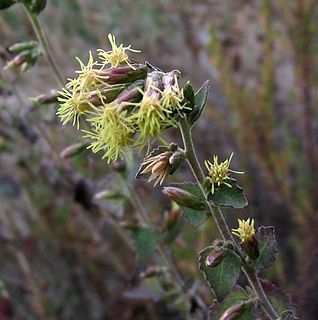
Eschscholzia californica, the California poppy, golden poppy, California sunlight or cup of gold, is a species of flowering plant in the family Papaveraceae, native to the United States and Mexico. It is cultivated as an ornamental plant flowering in summer, with showy cup-shaped flowers in brilliant shades of red, orange and yellow. It is also used as food or a garnish. It became the official state flower of California in 1903.

Smilax is a genus of about 300–350 species, found in the tropics and subtropics worldwide. In China for example about 80 are found, while there are 20 in North America north of Mexico. They are climbing flowering plants, many of which are woody and/or thorny, in the monocotyledon family Smilacaceae, native throughout the tropical and subtropical regions of the world. Common names include catbriers, greenbriers, prickly-ivys and smilaxes. Sarsaparilla is a name used specifically for the Jamaican S. ornata as well as a catch-all term in particular for American species. Occasionally, the non-woody species such as the smooth herbaceous greenbrier are separated as genus Nemexia; they are commonly known by the rather ambiguous name carrion flowers.

Umbellularia californica is a large hardwood tree native to coastal forests and the Sierra foothills of California, as well as to coastal forests extending into Oregon. It is endemic to the California Floristic Province. It is the sole species in the genus Umbellularia.

Juniperus californica, the California juniper, is a species of juniper native to southwestern North America.

Vitis californica, with common names California wild grape, Northern California grape, and Pacific grape, is a wild grape species widespread across much of California as well as southwestern Oregon.

Aesculus californica, commonly known as the California buckeye or California horse-chestnut, is a species of buckeye native to California and southwestern Oregon.

Frangula californica is a species of flowering plant in the buckthorn family native to western North America. It produces edible fruits and seeds. It is commonly known as California coffeeberry and California buckthorn.

Aristolochia californica, the California pipevine, California Dutchman's-pipe, or California snakeroot is a perennial woody vine of western North America.

Paeonia californica is a perennial herbaceous plant of 35–70 cm high, that retreats underground in summer, and reoccurs with the arrival of the winter rains. It has lobed leaves, elliptic (cup-shaped) drooping flowers with dark maroon-colored petals, and many yellow anthers. It flowers mostly from January to March, and later develops two to five fruits per flower. Its common name is California peony and it is sometimes also referred to as wild peony. This peony is an endemic of southwestern California (USA), where it is not rare, and northernmost Baja California (Mexico). It grows on dry hillsides in the coastal sage scrub and chaparral communities of the coastal mountains of Southern and Central California, often as an understory plant.

Artemisia californica, also known as California sagebrush, is a species of western North American shrubs in the sunflower family.

Asparagus asparagoides, commonly known as bridal creeper, bridal-veil creeper, gnarboola, smilax or smilax asparagus, is a herbaceous climbing plant of the family Asparagaceae native to eastern and southern Africa. Sometimes grown as an ornamental plant, it has become a serious environmental weed in Australia and New Zealand.

Encelia californica is a species of flowering plant in the daisy family known by the common name California brittlebush. It is also commonly referred to as "California coast sunflower" and "California bush sunflower".

Trixis californica , the American threefold or American trixis, is a species of flowering plant in the family Asteraceae. It is native to the southwestern United States in California, Arizona, New Mexico, and Texas, and in Mexico in the states of Baja California, Chihuahua, Coahuila, Durango, Nuevo León, Sinaloa, Sonora, Tamaulipas, and Zacatecas.

Gutierrezia californica is a North American species of flowering plant in the daisy family known by the common names San Joaquin snakeweed and California matchweed. It is native to California and Arizona in the United States and Baja California in Mexico. It grows in sunny sandy or rocky areas in grasslands, scrub, or open woodlands.

Brickellia californica, known by the common name California brickellbush, is a species of flowering plant in the daisy family.
S. californica may refer to:

Smilax jamesii is a species of flowering plant in the greenbriar family known by the common name English Peak greenbriar. It is to northern California, where it is known from the Klamath Mountains and the southernmost peaks of the Cascade Range. It has also been reported from nearby locations in southwestern Oregon. It grows in moist areas such as lakesides and streambanks in mountain coniferous forest habitat. It was discovered to be a new species when herbarium specimens thought to be Smilax californica were reexamined.

Suaeda californica is a rare species of flowering plant in the amaranth family known by the common name California seablite. It is endemic to San Luis Obispo County, California, where it is known from a few occurrences in the marshes around Morro Bay.

Smilax bona-nox, known by the common names saw greenbrier, zarzaparrilla, catbrier, bullbrier, chinabrier, and tramp's trouble, is a species of flowering plant in the Smilacaceae, or greenbrier family. The species is native to the southeastern United States from Delaware to Florida and as far west as Kansas and Texas, as well as Bermuda and much of Mexico.

Smilax tamnoides, common name bristly greenbrier, is a North American species of plants native to the United States and Canada. It is widespread from Ontario and New York State south to Texas and Florida.


















